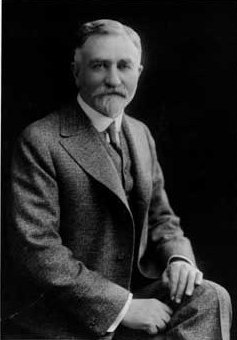Herbert Dow (Herbert Henry Dow)

Herbert Henry Dow was born in 1866 in Belleville, Ontario, the eldest child of the Americans Joseph Henry Dow, an inventor and mechanical engineer, and his wife, Sarah Bunnell, who were from Derby, Connecticut. When the infant boy was six weeks old, the family returned to their hometown. They moved again in 1878, this time to Cleveland, Ohio (United States) to follow Joseph’s job with the Derby Shovel Manufacturing Company. After graduating from high school in 1884, Dow enrolled in the Case School of Applied Science (now known as Case Western Reserve University). While at Case, he became a member of the Phi Kappa Psi fraternity. He began specialized research into the chemical composition of brines in Ohio and nearby areas. Herbert Dow discovered that brine samples from Canton, Ohio and Midland, Michigan were very rich in bromine, which at the time was a primary ingredient in medicines and was widely used in the fledgeling photographic industry. Following his graduation from Case in 1888, Dow worked for a year as a chemistry professor at Huron Street Hospital College in Cleveland, while continuing his research into the extraction of chemicals from brine. In 1889 Dow received his first patent after inventing a more cost-effective and streamlined process for bromine extraction. He quickly formed his own company but was bankrupt within the year. His associates were impressed with his work and in 1890 helped him to found the Midland Chemical Company in Midland, Michigan. Herbert Dow continued his work extracting bromine, and by early 1891 he had invented the Dow process, a method of bromine extraction using electrolysis to oxidize bromide to bromine.
Herbert Dow wanted to expand his research of electrolysis to yield other chemicals. His financial backers did not approve of his continued research and fired him from the Midland Chemical Company. He continued his research, developing a process to extract chloride and caustic soda from sodium chloride. After seeking funding from potential backers in Cleveland, including family friends and former Case School of Applied Science classmates, Dow secured funds from James T. Pardee, Albert W. Smith, J. H. Osborn, and Cady Staley. In 1895, Dow moved his young family to Ohio and founded the Dow Process Company to develop the production mechanism for his process. The following year he returned to Midland, where he formed the Dow Chemical Company as successor to the Dow Process Company. The Dow Process Company was incorporated with 57 original stockholders. Within three years, his new company purchased the Midland Chemical Company. With his new company and new technology, Dow produced bromine very cheaply, and began selling it in the United States for 36 cents per pound. At the time, the German government supported a bromine cartel, Bromkonvention, which had a near-monopoly on the supply of bromine, which they sold in the US for 49 cents per pound. The Germans had made it clear that they would dump the market with cheap bromine if Dow attempted to sell his product abroad. In 1904 Dow defied the cartel by beginning to export his bromine at its cheaper price to England. A few months later, an angry Bromkonvention representative visited Dow in his office and reminded him to cease exporting his bromine.
Unafraid, Herbert Dow continued exporting to England and Japan. The German cartel retaliated by dumping the US market with bromine at 15 cents a pound in an effort to put him out of business. Unable to compete with this predatory pricing in the U.S., Dow instructed his agents to buy up hundreds of thousands of pounds of the German bromine locally at the low price. The Dow company repackaged the bromine and exported it to Europe, selling it even to German companies at 27 cents a pound. The cartel, having expected Dow to go out of business, was unable to comprehend what was driving the enormous demand for bromine in the U.S., and where all the cheap imported bromine dumping their market was coming from. They suspected their own members of violating their price-fixing agreement and selling in Germany below the cartel’s fixed cost. The cartel continued to slash prices on their bromine in the U.S., first to 12 cents a pound, and then to 10.5 cents per pound. The cartel finally caught on to Dow’s tactic and realized that they could not keep selling below cost, they then increased their prices worldwide. Dow Chemical Company focused on research, and soon was able to extract many more chemicals from brine. World War I provided demand that enabled its growth, because Britain blockaded the ports of Germany, which at the time included most of the world’s largest chemical suppliers. Dow Chemical quickly moved to fill the gap for wartime goods, producing magnesium for incendiary flares, monochlorobenzene and phenol for explosives, and bromine for medicines and tear gas. By 1918, 90% of the Dow Chemical Company production was in support of the war effort. During this time period, Dow also created the diamond logo, which is still used by the Dow Chemical Company. By the time of his death on October 15, 1930 from cirrhosis of the liver, Herbert Dow had personally received over 90 patents. Dow was survived by his wife, Grace, and five of their seven children.
Born
- February, 26, 1866
- Canada
- Belleville, Ontario
Died
- October, 15, 1930
- USA
- Midland, Michigan
Cause of Death
- cirrhosis of the liver
Cemetery
- Midland City Cemetery
- MIdland, Michigan
- USA



